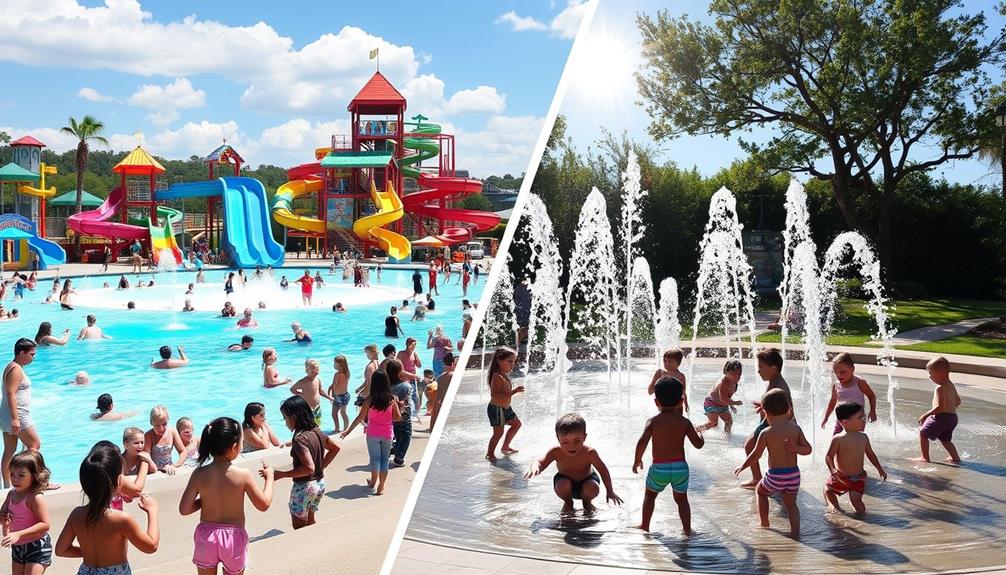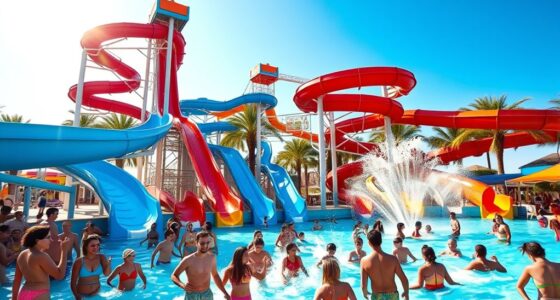Theme parks set height limits to guarantee your safety on rides, using detailed safety testing and engineering standards. Staff measure your height with a stadiometer or measuring stick at the entrance, making sure shoes are removed for accuracy. They enforce these rules strictly to prevent injuries and keep everyone secure. If you’re close to the limit, parks often have special passes or pre-measurements to help. To discover how these safety measures work behind the scenes, continue exploring.
Key Takeaways
- Parks establish height limits based on safety tests, engineering standards, and ride design to prevent injuries.
- Height is measured at the ride entrance using standardized tools like stadiometers, with shoes removed for accuracy.
- Staff are trained to enforce height restrictions strictly, using clear signage and proper measurement procedures.
- Alternatives like suitable activities or special passes help accommodate guests near height limits safely.
- Regular safety reviews ensure height requirements stay aligned with current research and engineering standards.

Ever wondered why certain activities or jobs have height requirements? It’s mainly about safety and ensuring that everyone can enjoy the experience without risking injury. When it comes to amusement parks, these limits are especially strict. Parks set specific height requirements to make sure riders can be secured properly in harnesses or restraints. If you’re too short, the safety features might not function correctly, increasing the risk of injury. Conversely, if you’re too tall, you might not fit comfortably into the ride’s restraints, which could also compromise safety. These limits aren’t arbitrary—they’re based on extensive testing and engineering standards designed to keep everyone safe. The enforcement of these requirements often involves precise measurement tools and trained staff to ensure accuracy and safety. When you visit a park, you’ll notice that height requirements are clearly posted at ride entrances. These measurements serve as a quick and simple way to determine whether a rider can safely experience the attraction. To verify your height, parks typically use a stadiometer or a measuring stick positioned at the ride entrance. Sometimes, they require you to stand flat-footed, without shoes, and keep your back against the measuring device. This ensures an accurate reading. Staff members are trained to assist if you’re unsure whether you meet the requirement. They might ask you to stand straight or remove shoes if necessary. In some cases, parks have designated measurement stations where you can be measured before waiting in line, preventing delays for guests who are borderline. If you don’t meet the height requirement, you won’t be allowed to ride. While this can be disappointing, it’s always for your safety. Parks often have alternative activities suitable for all heights, so you won’t feel left out. For children nearing the height limit, some parks have special passes or wristbands that indicate whether they qualify for certain rides. Parents or guardians should measure their kids at home beforehand to avoid surprises. Remember, trying to cheat the system by wearing bulky footwear or standing on tiptoes isn’t advisable. Staff are vigilant and trained to enforce the rules strictly, as safety is their top priority. Additionally, many parks regularly review and update their safety standards to incorporate the latest engineering research and safety protocols. Ultimately, height requirements serve as a simple, effective safety measure that helps parks manage risks and provide a fun, secure environment. They’re based on scientific assessments and engineering standards that ensure riders are properly secured and protected during their experience. By following posted signs and cooperating with staff, you contribute to everyone’s safety and help maintain the thrill and enjoyment that amusement parks are known for.
Frequently Asked Questions
How Do Rides Determine Height Measurement Methods?
Rides determine height measurement methods by using a combination of standardized tools and procedures. You’ll typically stand against a measuring device, like a stadiometer or a height stick, which is calibrated regularly for accuracy. Staff often verify your height with a quick visual check or a physical marker on your body, ensuring you meet the minimum or maximum height requirements. This process helps keep everyone safe while enjoying the attractions.
What Are the Consequences of Attempting to Bypass Height Checks?
If you try to bypass height checks, you risk serious safety consequences. Parks often have strict policies, and attempting to deceive the system can lead to being removed from the ride or even banned. You might think it’s harmless, but the ride’s safety features are designed for specific heights. Ignoring this puts you and others in danger, which is why parks enforce these measures strictly for everyone’s protection.
Are There Exceptions for Children or Individuals With Disabilities?
Yes, there are exceptions for children and individuals with disabilities. You might see accommodations like booster seats or wheelchair-accessible rides, but you still need to meet safety requirements. Always check with park staff for specific policies and assistance options. You’re responsible for ensuring safety, so follow all guidelines and communicate openly with staff if you or someone in your group needs special accommodations.
How Often Are Height Requirements Reviewed or Updated?
Ever wonder how often parks revisit their height rules? They typically review and update these requirements annually or whenever new rides open. This ensures safety standards keep pace with technological advances and rider safety needs. Parks actively monitor ride performance and safety data, making adjustments as necessary. So, your best bet is to check with the park’s official guidelines before each visit — safety isn’t something to take for granted!
Can Height Requirements Vary Between Different Parks or Attractions?
Yes, height requirements can differ between different parks or attractions. You’ll find that each park establishes its own standards based on ride safety and design, so what’s suitable for one may not be for another. Always verify the specific requirements for each ride before you go. This way, you avoid disappointment and guarantee your safety, making your experience more enjoyable and stress-free.
Conclusion
Next time you step onto a ride, picture the measuring stick as a gatekeeper, quietly ensuring your safety amid a whirl of colorful lights and roaring laughter. Height requirements aren’t just rules—they’re the key to a safe adventure, allowing you to soar confidently through twists and turns. So, measure up, follow the signs, and embrace the thrill knowing that every limit is set to keep your memories joyful and secure.










